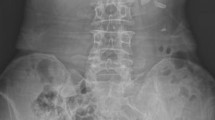Abstract
Purpose
Nephrolithiasis is common in patients with autosomal dominant polycystic kidney disease (ADPKD). Percutaneous management of nephrolithiasis is challenging because of a large number of parenchymal cysts and distorted calyceal anatomy. These patients also have varying grades of chronic kidney disease and are at increased risk of bleeding, which further increases the challenge. The objective of the study is to study the efficacy and safety of PCNL in ADPKD.
Materials and methods
We retrospectively analyzed twenty-two patients of ADPKD with renal calculi managed by percutaneous nephrolithtomy (PCNL) from January 2000 to January 2010. Patients were divided into two groups: group I (serum creatinine ≤1.5 mg%), group II (serum creatinine >1.5 mg%).
Results
PCNL was done in 25 renal units among 22 patients. Sixteen patients had chronic kidney disease, and the average stone burden was 2.4 cm ± 0.8 cm. The overall success rate (complete stone clearance/residual fragments <4 mm) was 88% (22/25). Two patients required relook PCNL for residual stone and one required ESWL for the incomplete clearance. Mean preoperative serum creatinine in group I was 0.9 ± 0.1 mg% and in group II 3.1 ± 1.2 mg%. There was improvement in serum creatinine in group II (1.4 ± 0.5 mg%) postoperatively. Three patients required blood transfusion (13%) and four patients had fever postoperatively (18%). None of the patients required angioembolization.
Conclusion
Despite the distorted calyceal anatomy and associated chronic kidney disease, PCNL is safe and effective in managing nephrolithiasis in polycystic kidney disease.


Similar content being viewed by others
References
Torres VE, Erickson SB, Smith LH, Wilson DM, Hattery RR, Segura JW (1998) The association of nephrolithiasis and autosomal dominant polycystic kidney disease. Am J Kidney Dis 11:318–325
Delaney VB, Adler S, Bruns FJ, Licinia M, Segel DP, Fraley DS (1985) Autosomal dominant polycystic kidney disease: presentation, complications, and prognosis. Am J Kidney Dis 5:104
Torres VE, Wilson DM, Hattery RR, Segura JW (1993) Renal stone disease in autosomal dominant polycystic kidney disease. Am J Kidney Dis 22:513
Gupta S, Seith A, Sud K, Kohli HS, Singh SK, Sakhuja V et al (2000) CT in the evaluation of complicated autosomal dominant polycystic kidney disease. Acta Radiol 41(3):280–284
Grantham JJ (2008) Autosomal dominant polycystic kidney disease. N Engl J Med 359:1477
Segal AJ, Spataro RF, Barbaric ZL (1977) Adult polycystic kidney disease: a review of 100 cases. J Urol 118:711
Dimitrakov D, Simeonov S (1994) Studies on nephrolithiasis in patients with autosomal dominant polycystic kidney disease. Folia Med (Plovdiv) 36:27
Christopher S, Agnes Y, Stevan B (2000) Nephrolithiasis associated with autosomal dominant polycystic kidney disease: contemporary urological management. J Urol 167:726–729
Grampsas SA, Chandhoke PS, Fan J, Glass MA, Townsend R, Johnson AM et al (2000) Anatomic and metabolic risk factors for nephrolithiasis in patients with autosomal dominant polycystic kidney disease. Am J Kidney Dis 36(1):53–57
Umbreit EC, Adam M, David E, Torres VE, Andrew JR, Matthew T (2010) Percutaneous nephrolithotomy for large or multiple upper tract calculi and autosomal dominant polycystic kidney disease. J Urol 183:183–187
Levine E, Grantham JJ (1992) Calcified renal stones and cyst calcifications in autosomal dominant polycystic kidney disease: clinical and CT study in 84 patients. Am J Roentgenol, vol 159, pp 77–81
Nishiura JL, Neves RFCA, Eloi SRM, Cintra SMLF, Ajzen SA, Heilberg IP (2009) Evaluation of nephrolithiasis in autosomal dominant polycystic kidney disease patients. CJASN 4(4):838–844
Al-Kandari AM, Shoma AM, Eraky I, El-Kenawy MR, Al-Eezi H, El-Kappany HA (2009) Percutaneous nephrolithotomy for management of upper urinary tract calculi in patients with autosomal dominant polycystic kidney disease. Urology 74:273–277
Amar AD, Das S, Egan RM (1981) Management of urinary calculus disease in patients with renal cysts: review of 12 years of experience in 18 patients. J Urol 125:153–156
Delakas D, Daskalopoulos G, Cranidis A (1997) Extracorporeal shockwave lithotripsy for urinary calculi in autosomal dominant polycystic kidney disease. J Endourol 11:167
Martinez Sarmiento M, Broseta Rico E, Sanz Chinesta S, Garcia Reboll L, Martin Abad L, Jimenez Cruz JF (1994) Extracorporeal shockwave lithotripsy in polycystic kidneys. Actas Urol Esp 18(1):35–38
Jhuang Y-B, Chung H-M, Wu T-M, Tsai Y-C (2009) Treating large renal stones in a case of Autosomal dominant polycystic kidney disease by flexible ureteroscopy with holmium laser lithotripsy. JTUA 20:140–142
Aron M, Yadav R, Goel R, Kolla SB, Gautam G, Hemal AK et al (2005) Multi-tract percutaneous nephrolithotomy for large complete staghorn calculi. Urol Int 75:327–332
Singla M, Srivastava A, Kapoor R, Gupta N, Ansari MS, Dubey D et al (2008) Aggressive approach to staghorn calculi-safety and efficacy of multiple tracts percutaneous nephrolithotomy. Urology 71(6):1039–1042
Shoma AM, Eraky I, El-Kenawy MR, El-Kappany HA (2002) Percutaneous nephrolithotomy in supine and prone position: technical aspects and functional outcome compared with the prone technique. Urology 60:388–392
Osman M, Wendt-Nordahl G, Heger K, Michel MS, Alken P, Knoll T (2005) Percutaneous nephrolithotomy with ultrasonography-guided renal access: experience from over 300 cases. BJU Int 96:875–878
Jones DJ, Russell GL, Kellett MJ, Wickham JE (1990) The changing practice of percutaneous stone surgery: review of 1000 cases 1981–1988. Br J Urol 66:1–5
Michel MS, Trojan L, Rassweiler JJ (2007) Complications in percutaneous nephrolithotomy. Eur Urol 51:899–906
El-Kenawy MR, El-Kappany HA, El-Diasty TA, Ghoneim MA (1992) Percutaneous nephrolithotomy for renal stones in over 1000 cases. Br J Urol 69:470–475
de la Rosette J, Dean A, Desai M, Jorge G, James L, Roberto S, Ahmet T et al (2011) The clinical research office of the endourological society, percutaneous nephrolithotomy global study:indications, complications, and outcomes in 5803 patients. J Endourol 25(1):11–17
Author information
Authors and Affiliations
Corresponding author
Rights and permissions
About this article
Cite this article
Srivastava, A., Bansal, R., Srivastava, A. et al. Percutaneous nephrolithotomy in polycystic kidney disease: is it safe and effective?. Int Urol Nephrol 44, 725–730 (2012). https://doi.org/10.1007/s11255-011-0090-z
Received:
Accepted:
Published:
Issue Date:
DOI: https://doi.org/10.1007/s11255-011-0090-z




